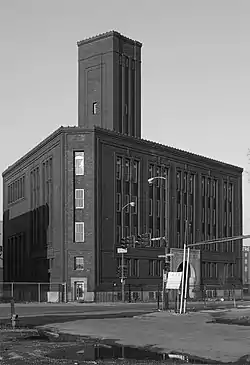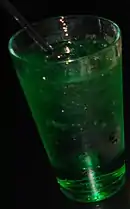Green River (soft drink)
Green River is a bright green, lime-flavored soft drink.[1][2][3] It was created by Richard C. Jones in Davenport, Iowa, sold widely by the Chicago-based Schoenhofen Edelweiss Brewing Company in 1919, subsequently sold by other vendors, and is currently manufactured by WIT Beverage Company.[1][4]

History

Green River soda was first created in 1916 Davenport, Iowa, by Richard C. Jones, who owned a local confectionary shop.[5] In 1919, Jones sold his recipe to the Schoenhofen Edelweiss Brewing Company of Chicago.[1] Prior to 1920, the brewery produced the popular Edelweiss beer. Schoenhofen began manufacturing Green River and other soft drinks in order to survive the Prohibition Era.[6] It was also made by the Sweetwater Brewery in Green River, Wyoming.
It was popular as a soda fountain syrup, trailing only Coca-Cola in popularity throughout the Midwest.[1][7] After Prohibition ended in 1933, the Schoenhofen Brewery continued to manufacture Green River, while resuming the production of alcoholic beverages.[1] The Brewery closed in 1950.[7]
The Green River brand continued to be produced by a series of other manufacturers after the closing of Schoenhofen Edelweiss in 1950,[7] including Clover Club Beverages of Chicago, which produced Green River in the 1980s[5][7] By 1992, Green River had shrunk to the point of only being sold in Seattle.[7] According to one source, Green River's current manufacturer, WIT Beverage Company, acquired the brand in 2011.[4] while a vendor indicates they were offering it still via an expanding Clover Club in 2013.[7]
Green River is frequently marketed as a nostalgia item, and its sales increase in March due to the association of the color green with St. Patrick's Day.[8] While not widely commercially available, it can be purchased at some Chicago area restaurants and retailers.
In popular culture

Early 20th century entertainer Eddie Cantor, while with the Ziegfeld Follies of 1918, penned a jingle for the soft drink entitled "Green River." The ditty was performed by Cantor and the singing duo, Van and Schenck.[9] The refrain was:[3]
For a drink that's fine without a kick,
Try Green River,
It's the only soft drink you should pick,
Try Green River.
The name of the Creedence Clearwater Revival song (and album) Green River was inspired by the drink according to John Fogerty.[4][10]
In Zen Studios' digital recreation of the Williams crossover pinball table The Party Zone in the game Pinball FX 3, all depictions of beer being served at the eponymous party are replaced with greenriver as a precautionary act of censorship to avoid repercussions of having the game's ESRB rating of Everyone 10+ changed.[11](13:05)
References
- Miastkowski, Raf (November 21, 2017). "Things You Didn't Know About Green River Soda". Thrillist. Retrieved November 24, 2017.
- Decker, Kristin (March 16, 2014). "Green River Soda: Made in Chicago". WGN Radio. Retrieved November 24, 2017.
- Granger, Bill (May 7, 1989). "Drinking In The Nostalgia: A Poll And A Pop Bring Back The Flavor Of The Fifties". chicago Tribune. Retrieved November 24, 2017.
- Haddix, C.; Kraig, B. (2017). The Chicago Food Encyclopedia. Heartland Foodways. University of Illinois Press. p. 289. ISBN 978-0-252-09977-9. Retrieved November 24, 2017.
- D, Amy (April 11, 2013). "A Davenport First: Green River Soda". Davenport Library Blog. Retrieved July 26, 2019.
- Dugan, John (March 8, 2011). "Schoenhofen Brewery, Chicago's beer riots and the brewer's star, and Chicago's historic breweries". Time Out Chicago. Retrieved November 24, 2017.
- "The Soda Depot - Green River Story". The Soda Depot. Archived from the original on September 20, 2013. Retrieved 27 December 2019.
- Heil, Meredith (November 20, 2017). "16 Hard-to-Find Sodas We Wish Were Everywhere". Thrillist. Retrieved November 24, 2017.
- "My Life Is In Your Hands," Eddie Cantor's 1928 autobiography, written with David Freedman.
- Bizzarri, A. (2016). Iconic Chicago Dishes, Drinks and Desserts. American Palate. Arcadia Publishing Incorporated. pp. 127–130. ISBN 978-1-62585-810-8. Retrieved November 24, 2017.
- "What's Censored in Williams Pinball Volume 2?". YouTube. The Crow Continuum. 6 January 2019. Retrieved 3 January 2021.